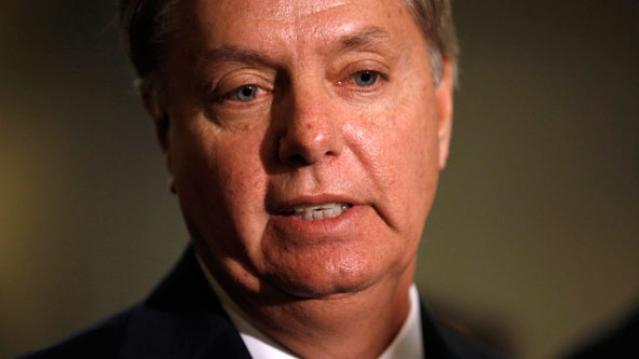Watch Lindsey Graham Destroy His Phone, Get a Bit of Revenge on Donald Trump

What do you do when Donald Trump gives out your cellphone number in a televised campaign rally? South Carolina Sen. Lindsey Graham, a Trump rival for the GOP presidential nomination, made the most of The Donald’s rude move by releasing a video in which he demolishes his phone (more than one, actually) by doing everything short of blowing it up.
Related: 7 Revelations from Donald Trump’s Financial Disclosure
The YouTube video, posted by IJ Review and titled “How to Destroy Your Phone With Sen. Lindsey Graham,” shows the senator smashing a Samsung flip phone in various ways — a golf club, a wooden sword, a cinder block — and also chopping it with a meat cleaver, putting it in a toaster oven with pizza bagels, dropping it in a blender with some Red Bull, lighting it on fire and dropping it from a rooftop.
“Or if all else fails, you can always give your number to The Donald,” Graham says toward the end of the 1:04 clip.
Related: The 2016 Presidential Election Is Already a Dumpster Fire
Graham isn’t exactly a technophile, so maybe he didn’t know he didn’t need to destroy his phone to get a new number (and there are much better ways to get rid of an old phone). More likely, though, the senator found a clever way to take advantage of the attention Trump provided for him and his campaign while also finally upgrading from his flip phone to a smartphone.
Probably getting a new phone. iPhone or Android?
— Lindsey Graham (@LindseyGrahamSC) July 21, 2015
Graham has struggled to make headway in a crowded Republican presidential field, drawing the support of less than 1 percent of registered GOP voters in recent polls. That would leave him off the stage in the Aug. 6 Fox News debate, which is limited to 10 of the 16 candidates. Trump, by the way, is almost assured of a spot. So the senator and his campaign need all the attention they can get — and the new video sure is getting attention. Since it was published to YouTube yesterday, it’s already been viewed more than 1 million times.
Chart of the Day: SALT in the GOP’s Wounds

The stark and growing divide between urban/suburban and rural districts was one big story in this year’s election results, with Democrats gaining seats in the House as a result of their success in suburban areas. The GOP tax law may have helped drive that trend, Yahoo Finance’s Brian Cheung notes.
The new tax law capped the amount of state and local tax deductions Americans can claim in their federal filings at $10,000. Congressional seats for nine of the top 25 districts where residents claim those SALT deductions were held by Republicans heading into Election Day. Six of the nine flipped to the Democrats in last week’s midterms.
Chart of the Day: Big Pharma's Big Profits
Ten companies, including nine pharmaceutical giants, accounted for half of the health care industry's $50 billion in worldwide profits in the third quarter of 2018, according to an analysis by Axios’s Bob Herman. Drug companies generated 23 percent of the industry’s $636 billion in revenue — and 63 percent of the total profits. “Americans spend a lot more money on hospital and physician care than prescription drugs, but pharmaceutical companies pocket a lot more than other parts of the industry,” Herman writes.
Chart of the Day: Infrastructure Spending Over 60 Years

Federal, state and local governments spent about $441 billion on infrastructure in 2017, with the money going toward highways, mass transit and rail, aviation, water transportation, water resources and water utilities. Measured as a percentage of GDP, total spending is a bit lower than it was 50 years ago. For more details, see this new report from the Congressional Budget Office.
Number of the Day: $3.3 Billion

The GOP tax cuts have provided a significant earnings boost for the big U.S. banks so far this year. Changes in the tax code “saved the nation’s six biggest banks $3.3 billion in the third quarter alone,” according to a Bloomberg report Thursday. The data is drawn from earnings reports from Bank of America, Citigroup, Goldman Sachs, JPMorgan Chase, Morgan Stanley and Wells Fargo.
Clarifying the Drop in Obamacare Premiums

We told you Thursday about the Trump administration’s announcement that average premiums for benchmark Obamacare plans will fall 1.5 percent next year, but analyst Charles Gaba says the story is a bit more complicated. According to Gaba’s calculations, average premiums for all individual health plans will rise next year by 3.1 percent.
The difference between the two figures is produced by two very different datasets. The Trump administration included only the second-lowest-cost Silver plans in 39 states in its analysis, while Gaba examined all individual plans sold in all 50 states.



